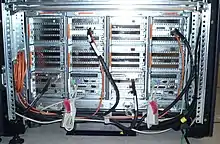The ES7000 is Unisys's x86/Windows, Linux and Solaris-based server product line.[1] The "ES7000" brand has been used since 1999, although variants and models within the family support various processor and bus architectures. The server is marketed and positioned as a scale-up platform where scale-out becomes inefficient. Typically the ES7000 is utilized as a platform for homogeneous consolidation, large databases (SQL Server and Oracle), Business Intelligence, Decision Support Systems, ERP, virtualization, as well as large Linux application hosting.
The hardware and software elements of the server are monitored by a software suite known as Server Sentinel.[2]
Architecture
Elements of the ES7000 architecture includes
- Multiple power domains
- N+1 redundancy for most components
- Subpod CPU scaling (4 cpu increment)
- Centralized memory/cache control
- Shared cache
- Point to point crossbar connections (fleXbar) among memory, processors, and I/O components
- Multiple I/O PCI bridges and buses
- Up to 8 direct I/O bridges each providing 3 independent PCI buses, supporting 96 PCI slots (On 100 and 200 series)
- Multiple memory storage units that can be combined or used separately
History
This server family has undergone several model revisions in its lifetime since 1999. Initially, the servers were standalone—physically the configuration resembled a rack and took up a somewhat larger footprint than a rack (Models 100, 130, 200, 230, 550, 400). Second and third generation ES7000s were rack mountable cells 4U or 3U high that fit in standard 19" racks.
First generation systems

- ES7000/100 Series - (1999/2000) Support for 32 Xeon processors, 64 GB RAM, 96 PCI slots under Microsoft Windows NT EE and Windows 2000 DC
Second generation systems
- ES7000/200 Series - Support for up to 32 Xeon Processors, 64 GB RAM, 96 PCI slots under Microsoft Windows NT EE and Windows 2000 DC
- ES7000/230 Series - Support for up to 32 Xeon Processors, 64 GB RAM, 96 PCI slots under Windows 2000 DC and Windows 2003 DC
- ES7000/130 Series - Support for up to 32 Itanium processors
Third generation systems

- ES7000/500 Series (510/420/530/540)
- ES7000/550 Series - Support for up to 32 Xeon processors, 64 GB RAM, 96 PCI Slots under Windows 2000 DC and Windows 2003 DC
- ES7000/400 Series (405/410/420/430/440) - Support for up to 32 Itanium processors and 128GB RAM under Windows 2000 DC and Windows 2003 DC
Fourth generation systems
- ES7000/600 Series - Support for up to 32 Dual Core Xeon or Itanium processors, 256 GB RAM, 40 PCI Slots under Windows 2003 DC
- ES7000/One Series - Support for up to 32 Dual Core Xeon or Itanium 2 processors, 256 GB RAM, 40 PCI Slots under Windows 2003 DC[3]
Fifth generation systems
- From late 2008, ES7000 7600R ("Kona") scalable from 1 cell of 24 cores to 4 cells of 96 cores of Xeon Hexcore and 1T of memory[4]
- Hexcore and high IO throughput crossbar make Kona twice the performance of previous top-of-the-line ES7000/one on half the cells, at a fraction of the price and 1/3 less rack space
- Built for green, scale-up database, scale-up virtualization (HyperV, VMware) and application consolidation workloads gaining performance and cost savings relative to many smaller, scale-out boxes (administration/maintenance, floorspace, heating, cooling)
- Number 1 TPC-E benchmark[5]
Form factors
The ES7000 models are broken down into three form factors.
- Cabinet/Frame size (A monolithic, midplane architecture, but deeper than a conventional rack)
- 4U Size Cell with up to 8 processors per cell and 8 PCI slots, up to four cells can be bound together to create a 32 cpu system)
- 3U Size Cell with up to 4 processor sockets per cell and 5 PCI slots, up to eight cells can be strapped together to create a 32 socket system)
Processors
The processors used in the ES7000 are:
- Intel Xeon
- Intel Multicore Xeon
- Intel Itanium and Itanium 2
- AMD Opteron[6]
Operating systems supported
ES7000 servers support the Microsoft Windows operating system both 32-bit Xeon and 64-bit Itanium, 32-bit and 64-bit versions of some Linux operating systems, and the Solaris Operating System.
- Windows: 2003 and Windows 2008
- Linux: Novell SUSE Linux Enterprise Server and Red Hat Enterprise Linux
- VMware: ESX 3.02 and ESX 3.5
- Unisys OS2200
- Unisys MCP
- Solaris
References
- ↑ "High End Enterprise Servers". Archived from the original on January 29, 2009. Retrieved 2009-02-20.
- ↑ "Unisys | Autonomic Computing Functions | Enterprise Server Product Capabilities". Archived from the original on 2008-02-15. Retrieved 2007-11-12.
- ↑ Server Snapshots: Spotlight on Unisys
- ↑ "Unisys | IT Management Solutions | High End Enterprise Server Models". Archived from the original on 2008-12-04. Retrieved 2008-12-22.
- ↑ http://www.tpc.org/tpce/results/tpce_perf_results.asp
- ↑ "ES7000 Enterprise Servers". Unisys. Archived from the original on March 31, 2009. Retrieved 2009-04-13.